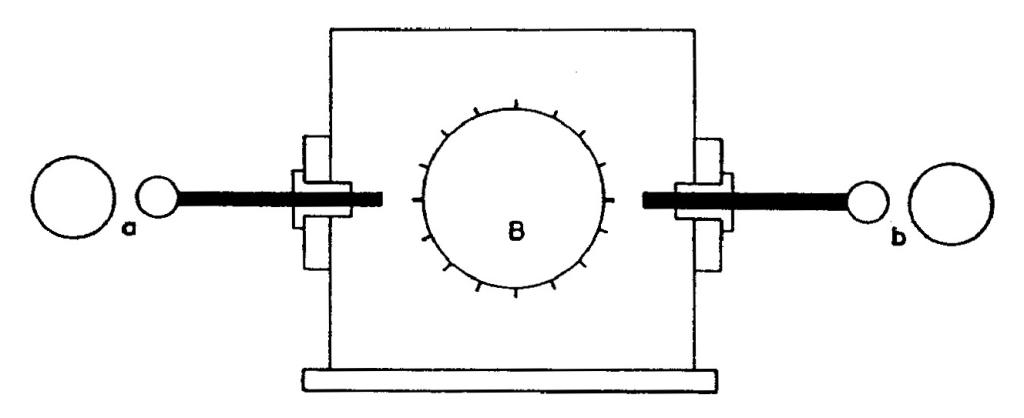
Nikola Tesla Books
lete analogy is afforded in mechanics. In order that free vibration may take place, and readily, there must be a loose connection with the part impressing the movement. This truth is obvious. Considerations of this kind led to experimentation with an arrangement, as illustrated in the sketch below: In this the connection with the secondary S impressing the movement was loosened, so to speak, by the insertion between it and the coil C to be excited another coil c which was generally adjusted to suit the conditions.
This amounted to the same as increasing the momentum of coil C and rendering it more preponderating and capable of freely asserting itself. These experiences lead to a rule long recognized, that development of the oscillator must be in two directions: either in the direction of obtaining a high impressed electromotive force by transformation ratio, when the connection between the secondary and primary is rigid; or obtaining a high e.m.f. by an excited extra coil in loose connection not reacting inductively.
Colorado Springs
July 27, 1899
Experiments were made today with spark gaps constituted as indicated in the sketch below: The idea in this scheme was to make gaps in the box, which varied from a very small to a great length owing to the movement of the break wheel B, very small and the gaps a and b very large, so large that the discharge could break through only when the gaps in the box were at their minimum length.
Thus the loss in the box itself was greatly reduced and owing to the great velocity of separation of the electrodes, a greater suddenness of disruption was obtained. This was, of course, certain since the gaps in the box could not be bridged except for a short interval since gaps a and b took up the e.m.f. Thus the velocity of separation was the greater the smaller (in length) the arcs in the box were made. The adjustment of their length was effected by merely varying the length of gaps a and b. In these experiments spheres of various sizes were used to constitute the ad-
108
July 26
This entry is concerned with much the same topics as that of June 30th. He investigated the influence of the HF transformer primary-secondary coupling on the 8th of July.
July 26
Tesla considers the same questions as on June 30, and he repeats them in greater detail now. The influence of a link between the primary and secondary of the oscillator high frequency transformer he considered on July 8.
July 27
In his first arcing-type oscillator for high frequency current production in 1891(4,15) Tesla used a simple "air gap" for the regulation of the oscillator capacitor charging and discharging. Already in the next year he describes several methods for improved operation of simple arcing devices by application of a magnetic field, or an air stream or quick spark interruption and the increase of capacitor charge and discharge frequency. Also he described the advantages of a "divided spark" in multiple small air gaps, when due to increased flashover voltage of a divided arcing device* in comparison with simple arcing device (of the same total air gap length) small gaps can be applied and the losses are smaller.
Fourth method for the achievement of capacitor charging and discharging improved system consisted in the application of various rotating breakers(5).
In patents over the period 1893-1898 Tesla protected several types of breakers or "electrical circuit regulators". It is interesting that all these patents pertain to various types of rotating breakers (with air gap and without). Some of the rotating breakers are protected in an assembly of apparatus for high frequency currents production. Among them are:
- Rotating arcing device (breaker without contacts) in oil made in the shape of a turbine, over which blades the capacitor circuit is made and interrupted, and it rotated by means of oil under pressure(50).
- Mechanical regulators of electrical circuit of the "on-off" type for operation with direct current(51).
- Synchronous regulators of electrical circuits with regulation of the instant of interruption for operation with alternating current sources or without it(52).
- The commutators for alternating "on-off" switching, or connection of two capacitors in Tesla's oscillator primary circuit(53).
In 1897 and 1898 Tesla obtained a number of patents in the field of "electrical circuit regulators. The basic requirement is that these regulators establish and interrupt electrical circuits at the highest possible speed. Further it is required to achieve a great number of operations per time unit. In eight patents(27) Tesla described the design of rotating breakers with conductive or nonconductive fluids. conductive fluid is usually mercury and nonconductive oil. At some regulators the interruption is performed in inert gas under pressure. Extraordinary are the solutions for the achievements of microjets which create a contact with two rotors made of metal for the achievement of two microjets (fluid contact).
Rotating arcing device with two auxiliary gaps as on the Figure is one new solution. Probably additional gaps were applied by Tesla in order to regulate by means of them, the excitation during operation with high voltages. It can be seen from the text that this is possible to achieve when it is mentioned that by means of those gaps it is possible to shorten the supply interval from the network transformer secondary. At the end of his consideration Tesla says he achieved the best results with two rotating arcing devices, (tooth shaped) which rotate in opposite directions. He didn't explain how he chose the number of "teeth" on each rotating disc in order to get the number of interruptions equal to the product of the number of "teeth".
* The total resistance of air gaps connected in series at multiple gap arcing device is smaller than the resistance of usual arcing device of the same flashover voltage.



